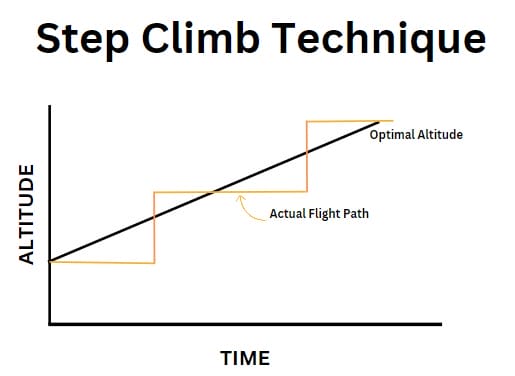During the pre-flight phase, the flight crew of the aircraft conducts flight planning for the flight. As part of this flight planning, the routing, weather, speeds, and cruise altitude are determined. For a conventional short to medium-haul flight, a cruising altitude is filed as part of the flight plan.
In some instances, in which the flight time and distance are longer, the cruising altitude of the aircraft may change based on a number of operational factors.
What is a Step Climb?

This incremental shift in cruising altitude throughout a flight is known as a step climb. A step climb is an increase in altitude in order to improve fuel efficiency. The higher in the atmosphere, the thinner the air is. If possible, aircraft should fly at the optimum cruising altitude throughout the flight.
As noted above, short to medium-haul flights will generally not involve step climb procedures. During these flights, the aircraft generally maintains the same cruising altitude throughout the duration of the flight.
This is primarily due to the fact that aircraft are within a performance range in which optimal cruising altitude can be reached soon after departure.
Step climbs are more commonly performed during longer flights, in which the aircraft starts the flight with a fuel and payload weight which would make it not possible to fly at higher altitudes.
Usually, an initial cruising altitude is filed on the flight plan, with performance calculations being made via the aircraft FMS to determine at what points throughout the flight the aircraft can step climb to its next higher flight level.
As part of these FMS calculations, there is a built-in automated performance (PERF) section that analyses the aircraft weight and informs the maximum altitude the aircraft can fly at that current point and also the optimal altitude.
It is common practice in order to maximize fuel economy for airline SOPs to state that flights should be flown at the closest cruising altitude possible to this optimal altitude calculation.
As a flight progresses and as more fuel is burnt, the optimal cruising altitude will increase. On modern FMS systems, estimated en route cruise altitudes are aligned with flight plan waypoints throughout the flight.
The exact step climb altitude increase will depend on a number of factors. ATC permissions, airspace, and performance calculations are the primary factors.
Generally, step climb altitude increments range from 1,000ft to 4,000 ft. At altitudes classified as RVSM (FL290 – 29,000ft and above), the increments will generally be 1,000 ft. Below 29,000 ft, this is generally 2,000 ft.
Depending on ATC constraints and permissions, a step climb may or may not be permitted to an aircraft. This will usually come down to the congestion of the airspace in which the aircraft is.
Step climbs can often be critical on long-haul flights in which cruising at an initial altitude for the entirety of the flight would be unsustainable in relation to fuel.
Instances in which step climbs are not permitted on request to ATC can lead to enroute diversions for refueling purposes as a result.
Aside from aircraft weight limitations on departure restricting initial cruising altitude, there may be an airspace-related element.
In congested airspace, an aircraft may not be assigned its desired cruising altitude. Instead, it may be issued with an intermediate flight level initially. This is a common occurrence on busy air routes around the world. The North Atlantic is a common example.
As a result of this, long-haul flight planning is a complex and extensive process in which the most optimal routing has to be selected. Optimal routing includes factoring in en-route weather, aircraft limitations, and total distance.
On transoceanic flight planning, this is even more extensive due to the requirement for the aircraft to be within its certified ETOPs alternate airports time range at all times.
Step climb procedures form an extensive part of an airline’s long-haul fuel economy operations, in which there is an opportunity for fuel burn to be reduced to some degree if engaging in step climb procedures.
With the majority of long-haul commercial aircraft having a service ceiling of 40,000ft or above, there is a suitable margin for availing of step climbing in most operational circumstances.
Read More:
Top of Descent (T/D) Calculations

After visiting more than 60 countries, I have probably been on every type of plane there is and visited countless airports. I did my very first international solo trip to South Africa at the age of only 16 and haven’t really stopped traveling since.
Despite the adventurous travel itch, I do have a nerdy side as well – which is satisfied by writing about all things aviation “too boring” for my regular travel blog.
